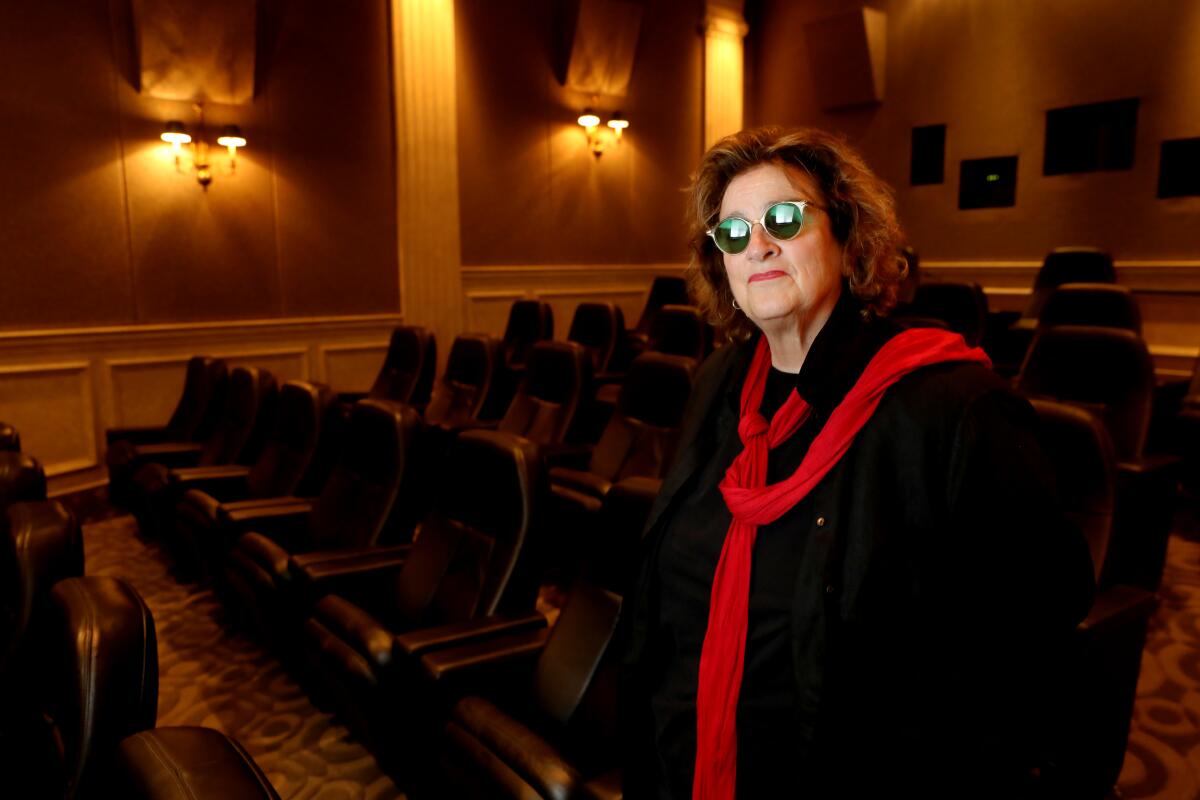How Tarantino’s team made the ultra-’60s Hollywood in ‘Once Upon a Time’

- Share via
Quentin Tarantino’s “Once Upon a Time ... in Hollywood” is a nostalgic fable, alternate history, love letter to film, violent fantasy. Production designer Barbara Ling says it’s also very personal.
“It is his epic. It’s extremely personal to Quentin,” she said on the Sony lot. “He always says, ‘This is how I became a filmmaker. Growing up [here], my mom letting me go to movies really early. Watching TV. Whenever I could, going to the bookstore or poster shop, getting another comic.’ Everything was geared toward what he was reading and watching.”
Tarantino’s deep knowledge of the area — Hollywood, the Valley — fuels the world of the film, just as Los Angeles native Ling’s does.
“He wanted as real as we could get, and not just landmarks. He would say, ‘I really like Van Nuys Boulevard. As a kid, I was driving on Van Nuys Boulevard in Panorama City — that’s where we used to go shopping.’
The greatest line he ever said to me in terms of how things [for the film] were perceived was, ‘Imagine an 8-year-old lying in the back of his mom’s car, and his point of view.’
— Barbara Ling
“The greatest line he ever said to me in terms of how things [for the film] were perceived was, ‘Imagine an 8-year-old lying in the back of his mom’s car, and his point of view.’ ”
Much has been made of the film’s restoration of 1969 Hollywood — the era-appropriate mural on Hollywood’s Aquarius Theatre, so many iconic façades in Westwood Village and Hollywood Boulevard. The production even repainted crosswalks to resemble those of the time.
But perhaps more telling are the tiny details: filmmaking choices that came from the heart of an 8-year-old lying in the backseat of his mother’s car.
“I said, ‘OK. The signs, I could build, full-scale: Roy Rogers restaurant, the Earl Scheib, the Holiday Inn,’ ” said Ling.
“Another thing you remember from Van Nuys is those enormous electric and telephone lines. You saw the signs through the lines. So we put lines up, telephone poles, then billboards and signs. So when you saw Cliff [Brad Pitt’s character] making that drive, Quentin’s shooting it from his 8-year-old point of view. You’re looking up through the side window,” she says.
Design elements also express character and even generate tension. Cars, clothes and colors speak to characters’ social status and personalities. TV star Rick Dalton (Leonardo DiCaprio) lives in a sleek Benedict Canyon bachelor pad that feels like a shrine to Rick Dalton. His stunt double and driver, Cliff Booth, lives in a tin-can trailer behind a Valley drive-in, near oil derricks.
In the movie’s most stressful sequence, Cliff arrives at Spahn Ranch, the real-life disused location for Westerns at which he and Rick used to make their fictional TV show (the production created its own version of the ranch). He finds the remote property occupied by mysterious “hippies” who later turn out to be the Manson Family. Cliff has to all but force his way into the owner’s house to see if his old friend, George Spahn, is all right. Inside, as he calls out to no response, he cautiously makes his way through worrisome clutter — dirty dishes, bugs, a mouse dying in a glue trap.
“I love the way [the camera] crept — the way they lit. His eyes were darting — ‘This would never be George, to live like this,’ ” said Ling.
“George had a wife he was wild about. She died before him. One of those station wagons in front, we made to look like hers. He never moved it so when he looked out his front porch, he’d see his wife’s station wagon. They had a lovely little house.
“Now the Mansons had been holed up there for a couple of years and are slobs and nobody cleans up. I love the way they shot that because it makes you go, ‘Whoa.’ ”

Ling also worked on another movie inspired by real events and partially set in late-’60s Hollywood — Oliver Stone’s “The Doors.” Tarantino watched it for research, absorbing the design infused by Ling’s own experience.
“’69 was the height of posters, head shops,” Ling said. “[Tarantino] wouldn’t have been a part of that at 6 or 8. I was older than Quentin; I was 15 or 16, so I have more memories.”
Ling was after a particular blacklight poster she learned was called “Peace,” which the team finally found on eBay. They bought it but still needed the original, as well as permission from the artist, Rik Vig. When they called him, his wife answered.
“She said, ‘It’s so strange you’re calling; my son and I were just trying to buy that poster on eBay because we don’t have a copy.’ ”
The team said they had that copy and would gladly give it to Vig’s family if they could use the poster in the film. “She said, ‘My husband would be over the moon to hear this. Sadly, I’m sitting next to him right now … he’s passing. I’m going to say in his ear, “Honey, you’re going to be in a Quentin Tarantino movie.” ’ ”
More to Read
Only good movies
Get the Indie Focus newsletter, Mark Olsen's weekly guide to the world of cinema.
You may occasionally receive promotional content from the Los Angeles Times.









